Norton LifeLock scam emails: what you need to know
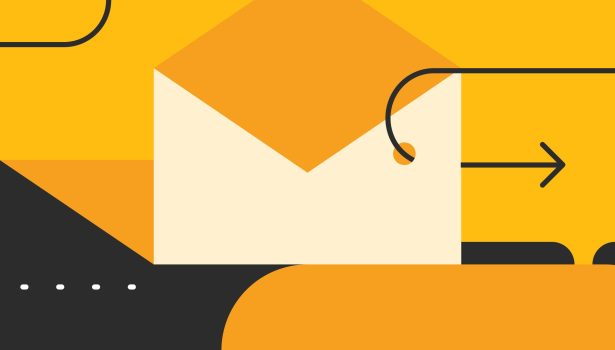
You might think that being scammed after subscribing to an antivirus and identity theft protection service is the least possible thing to happen, but scammers exploit just about any opportunity. In an increasingly widespread scamming operation, bad actors send out Norton LifeLock scam emails impersonating the popular brand to steal people’s money or valuable personal information.
Read on to learn the telltale signs of Norton antivirus scam emails, including those mentioning LifeLock, its identity theft protection service that’s part of the Norton product family. We’ll also cover the steps to take if you’ve been scammed, and how to protect yourself from scam emails and phishing attacks going forward.
What is a Norton LifeLock scam email?
Norton LifeLock scam emails have become one of the most common types of phishing attacks targeting consumers. These fraudulent emails impersonate Norton, a popular cybersecurity software brand, and LifeLock, its identity theft protection product, with the goal of tricking recipients into handing over financial or personal information.
In some cases, the targets are not even Norton’s or LifeLock’s actual subscribers. It’s enough for scammers to just get hold of your email address—via data breaches, social engineering, the dark web, or public data broker websites—to target you in a Norton phishing attempt.
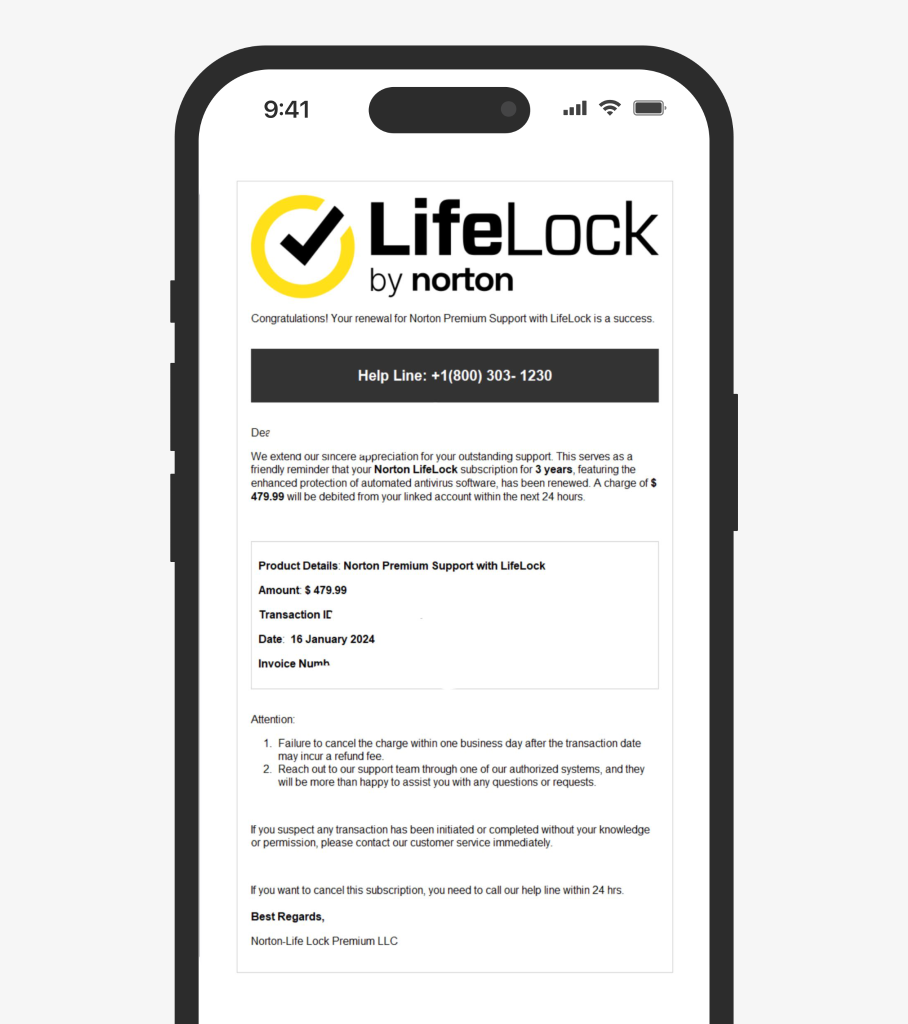
Norton LifeLock is just one in the lineup of many brands commonly impersonated by scammers. Other frequent examples include Apple support impersonation, Xfinity scams, and USPS scam texts, to name a few.
According to the FBI’s Internet Crime Report, phishing and spoofing were also the largest category of reported scams in 2024, with 193,407 complaints and $70 million lost—up from $18.7 million the year before. Brand impersonation and fake subscription renewal scams are among the fastest-growing threats, making it crucial to learn how to recognize and prevent these malicious attacks.
How the Norton LifeLock scam works
The typical Norton renewal scam claims your subscription has been renewed or is about to expire and urges immediate action. Most of these emails contain an “invoice” listing charges between $200 and $700 and provide a support phone number to “cancel” the transaction.
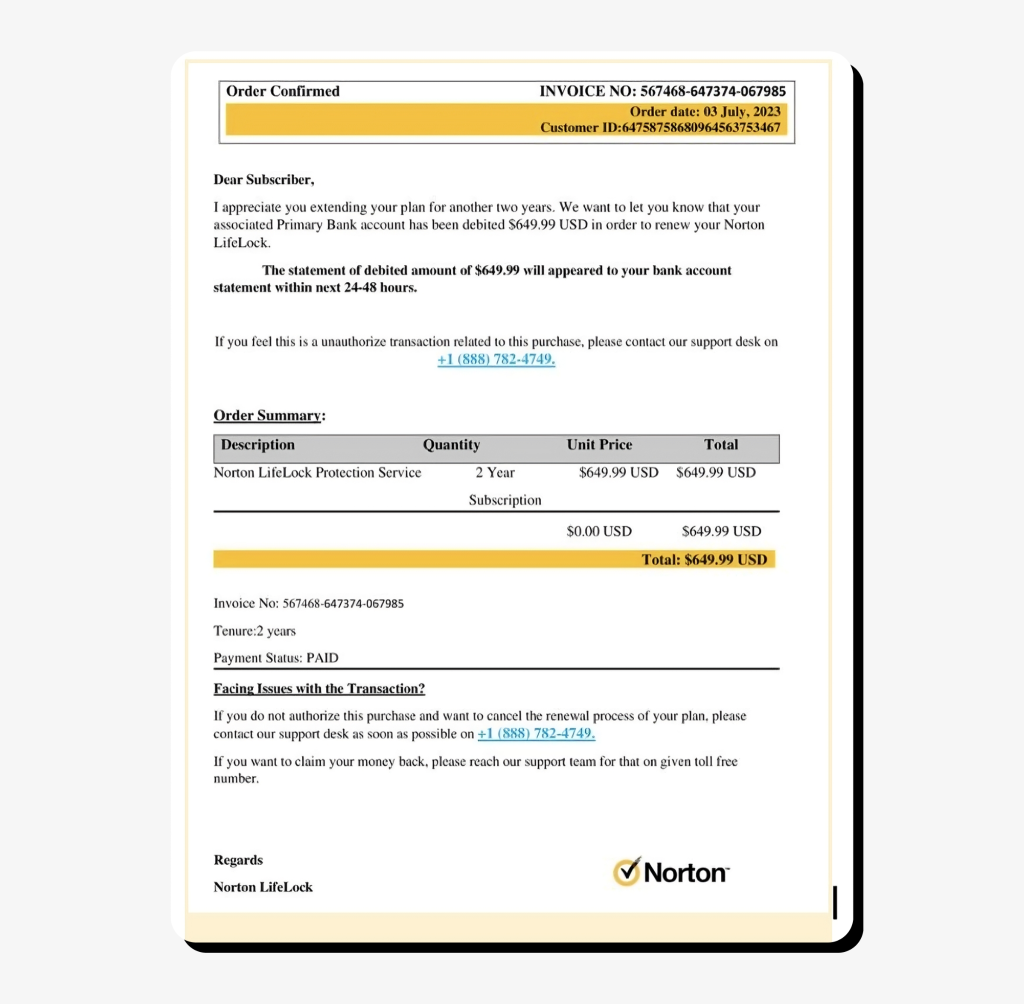
In some cases, these scams start as Norton order confirmation emails and proceed by listing a “help line” phone number for reverting the transaction.

These scam emails deliberately alarm users with a large sum of money, prompting them to call the phone number provided to get on the line with scammers. They then manipulate their targets into either giving away personal information, such as credit card data, or just sending money straight away. Instead of calling, you may be prompted to click a link that takes you to a spoofed subscription cancellation page.
To make these emails more believable and bypass spam filters, scammers occasionally insert a DocuSign document to be signed to confirm the user’s “account update.”

If you call the provided “help line” phone number, click the link in the email, or download an attachment, scammers will be able to:
- Request remote access to your computer, like in AnyDesk scams, pretending to help you initiate a refund while stealing your credit card data and bank account credentials along the way.
- Harvest sensitive data, such as payment card details and login credentials.
- Trick you into sending money via wire transfer, gift cards, or cryptocurrency.
- Install spyware on your device that steals information you enter.
This is a common variation of a refund scam, also found in Geek Squad scams, where the recipient is told to get back in touch to revert a transaction stated in the “invoice.” In reality, this is a ploy to provoke anxiety and make people rush their decisions without verifying the information through official sources.
How to spot a Norton LifeLock phishing email
Recognizing the warning signs of a Norton scam early can help you curb the threat and avoid falling victim. Here’s a list of red flags to watch out for, which also apply to phishing emails in general:
- Urgent or alarming subject lines, such as “Account action needed!”
- Generic greetings like “Dear Customer” or “Dear [your email address]” instead of your full name, which legitimate companies would have on file.
- Suspicious sender addresses that don’t come from an official Norton or LifeLock domain, especially those using @gmail.com, @yahoo.com, or @aol.com.
- Fake invoices for services that you don’t remember purchasing.
- Random phone numbers listed as Norton’s or LifeLock’s help line, which don’t match official support numbers (as of this writing, LifeLock’s listed customer support phone number is 1-800-416-0599).
- Suspicious links that don’t lead to norton.com or lifelock.norton.com when you hover over them.
- Attachments disguised as invoices or documents that prompt you to download them.
- Urgency or threats: scam emails typically state that you have “one business day” to cancel the charge, or mention some strict deadline for your action to make you address the issue as soon as possible, otherwise you might face “account suspension” or “refund charges.”
- Grammatical errors and strange phrasing, which are common in phishing attempts. Note, however, that with the rise of generative AI, scammers can create persuasive and linguistically perfect scripts, so this red flag becomes less prominent.
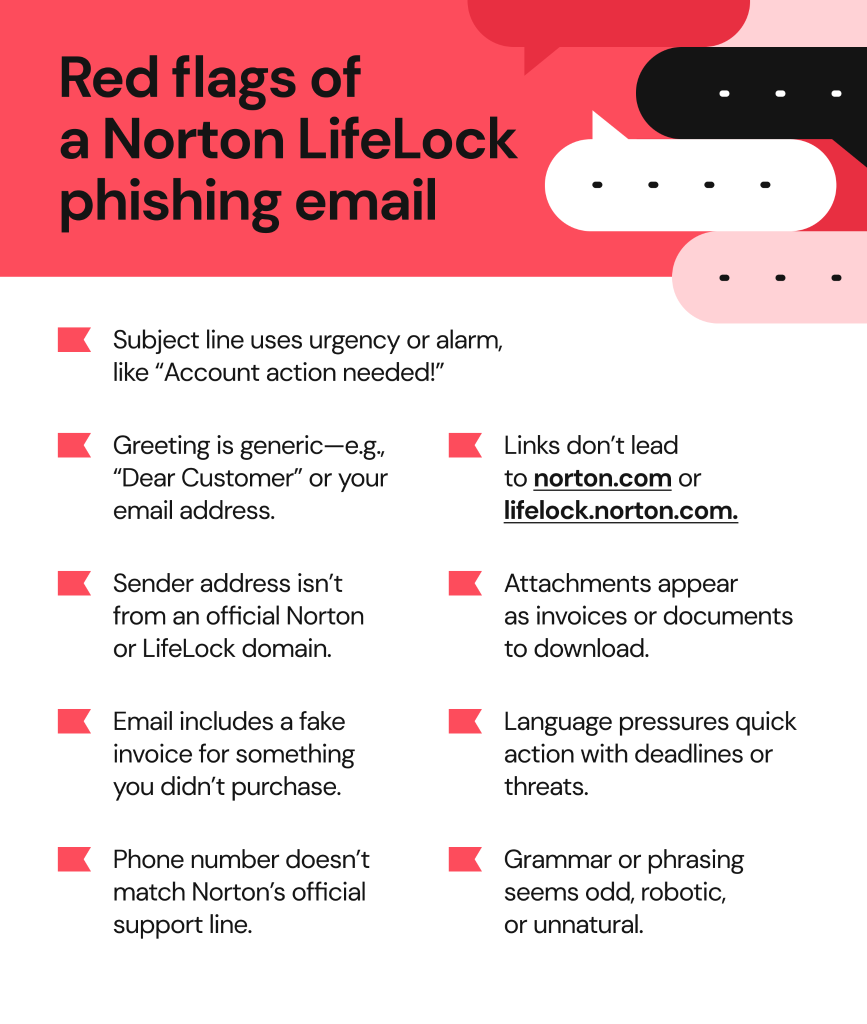
What to do if you receive a Norton LifeLock scam email
You may receive a Norton scam email whether or not you’re their actual subscriber. If you get one, take the following immediate steps:
- Do not click the links or call the phone numbers in the email.
- Mark the email as phishing in your email application.
- Report the email as a scam to Norton by forwarding it as an attachment to [email protected]. If you received a scam email impersonating Norton LifeLock, forward it to [email protected].
- Once forwarded, take screenshots for further reporting to relevant authorities.
- If you’re a Norton subscriber, access your user account via their official website and check your status. In case you have further questions, contact their official customer support.
What to do if you interacted with the scammers
If you clicked the link, regardless of whether you entered any information, downloaded the attachment, or called the phone number provided in the email, take the following precautions:
- Do not call them back or provide further information.
- Disconnect any remote device access session, if active, by shutting down your device.
- Clear your browser cache, cookies, and saved logins and passwords.
- Run a full antivirus scan using your trusted software provider for any traces of malware installed.
- Change your passwords for affected digital accounts and enable two-factor authentication for added protection.
- Keep an eye on unusual device behavior, such as slow performance, glitches, or pop-ups.
- If you shared personal or financial information, such as your Social Security number, credit card, or banking details, contact your bank or card issuer immediately. Request to block and reissue your card and reverse any unauthorized transaction.
- If you sent money to the scammers, request a chargeback or ask your bank to place a hold on the wire transfer for fraud-related reasons.
- Monitor your banking transactions continuously and consider placing a credit freeze with credit bureaus (e.g., Equifax, Experian).
- Sign up for an identity theft protection service to monitor any misuse of your personal data.
- Stay alert for follow-up scams. Scammers often target the same victims again, offering fake scam recovery services to steal more money or information.
Reporting the scam to authorities
It’s important to know that although Norton LifeLock has acknowledged the rise in subscription renewal scams, there’s practically nothing they can do in terms of scam recovery except review your scam report.
If you’re looking to recover lost funds, prevent potential identity theft, or seek legal help, you should contact the relevant authorities:
- Document everything, including the sender’s email address, email content, and how the scam unfolded if you interacted with the scammers.
- File a complaint with the Federal Trade Commission.
- Report the scam to the FBI’s Internet Crime Complaint Center (IC3).
- Submit a report to the Better Business Bureau’s Scam Tracker to warn others of potential threats.
- Look up your local state consumer protection office and seek their assistance.
- File a police report with your local police department, especially if your money was stolen. This report may be required by banks or insurers for reimbursement.
How to protect yourself from phishing and email scams
Here’s a detailed playbook on how to protect yourself from email-based scams, drawing from best cybersecurity practices.
Verify the sender
Always verify the sender and be skeptical of unsolicited emails, especially if you’re not the company’s customer. Look beyond the display name in the sender field and verify the full email address. Scammers often use lookalike domains that are easy to confuse with legitimate ones (for example, [email protected] instead of [email protected] in case of LifeLock scam emails).
Don’t click links or download attachments
Never interact with content in suspicious emails. Hover over links before clicking and check if they lead to an official domain. Be extra cautious with attachments—many malware infiltrations and ransomware attacks start this way.
Question the urgency
If the email only gives you a couple of hours or days to act, pause and think about whether this urgency is justified. Pressure and scare tactics are frequently employed by scammers who want you to act quickly before the email is lost in your inbox.
Validate the information through official channels
One easy tactic to curb impersonators’ exploits is to verify the information through the company’s official support channels. For this, don’t use the links or phone numbers provided in the email. Instead, go directly to the company’s official website and call the customer support number listed there.
Use email security tools
Spam filters, firewalls, and antivirus programs help block suspicious messages. Some services like Gmail and Outlook may also alert you to risky messages. They also have built-in spam and phishing flagging features.
Use strong login credentials
Use strong, unique passwords and avoid reusing them across different accounts to prevent credential stuffing attempts. A password manager can help you generate and store complex credentials for every account. Enabling multi-factor authentication is also essential, as even if scammers steal your password, they still won’t be able to take over your account. Use a device-based authenticator app or hardware key instead of SMS for stronger protection.
Remove your email address from the internet
You don’t have to be a brand’s customer to be targeted in an impersonation scam.
Scammers obtain email addresses online and blast phishing emails by the thousands, hoping to reach at least some success, without checking whether your email is actually listed among the brand’s users. Public data brokers, however, make it even easier for them. By obtaining email addresses from data broker websites, scammers can craft personalized phishing messages and make you more likely to fall for them.
You can remove your email address from public records and data brokers using Onerep, and complement it by a dark web monitoring tool to see if your email has been leaked on the dark web.
FAQs
Is Norton LifeLock a legitimate service?
Yes, Norton LifeLock is a fully legitimate identity theft protection and dark web monitoring product that is now offered as part of the Norton 360 subscription service. Norton LifeLock scams come from impersonators using the brand name to target users with phishing emails, not from the company itself.
How do I know if my Norton subscription is real?
Always verify by logging directly into my.norton.com. Genuine Norton LifeLock emails typically include the user’s full name, billing information, and purchase history, which are often omitted by scammers. If in doubt, contact Norton’s official customer support to verify your subscription status.
Can I get my money back if I was scammed?
Recovery depends on how you paid and how fast you act. If you used a credit card, contact your credit card issuer immediately and dispute the charge—many providers have zero-liability policies in cases of fraud. Payments via gift cards and cryptocurrency are rarely recoverable, but reporting them can still aid the investigation.
Are Norton LifeLock scam emails the same as tech support scams?
They overlap but aren’t always identical. Some Norton LifeLock email scams evolve into full-blown tech support impersonation where scammers trick users into granting remote access to their devices. In other cases, the scam is simply a false subscription renewal alert designed to harvest sensitive information via phone calls or spoofed links.


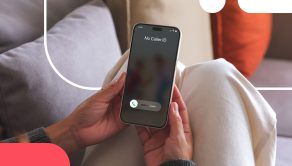

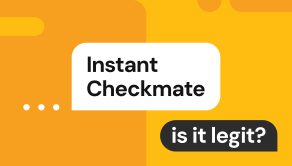
Mikalai is a Chief Technical Officer at Onerep. With a degree in Computer Science, he headed the developer team that automated the previously manual process of removing personal information from data brokers, making Onerep the industry’s first fully automated tool to bulk-remove unauthorized profiles from the internet.